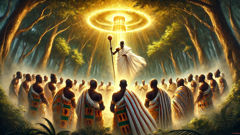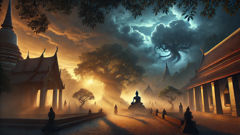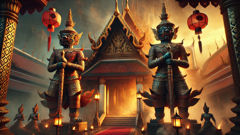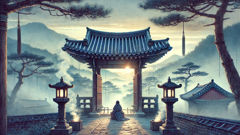Introduction
In the dense, emerald heart of what is now Ghana, stories swirl like the early morning mists that roll between the ancient trees. Among these stories, none carries as much awe or reverence as the legend of Okomfo Anokye—a name whispered with pride and wonder throughout generations. Born at a time when the Akan clans were scattered and restless, Okomfo Anokye’s arrival was said to have been foretold by dreams and marked by inexplicable omens: a child born clutching strange talismans, his cries echoing like distant thunder, his gaze already carrying the weight of destiny. The land was restless too. Rival clans vied for supremacy, their conflicts leaving scars on the earth and hearts alike. Yet, hope glimmered among the Ashanti, who longed for unity, peace, and a place in the sun. Into this era stepped Okomfo Anokye, a figure shrouded in mystery—half healer, half sage, all legend. His presence alone stilled quarrels. Villagers swore he could command the rain, heal the dying, and speak with the ancestors. But it was neither his miracles nor his mastery of sacred rites that would seal his place in history. It was his unyielding vision for the Ashanti people: that their greatness lay not in conquest or gold, but in unity, honor, and the invisible threads binding one soul to another. The legend of Okomfo Anokye is more than a tale of magic; it is the heartbeat of a people and the dawn of an empire.
The Child of Prophecy and the Gathering Storm
Long before the name Okomfo Anokye would become synonymous with power and unity, his birth was wrapped in signs that set him apart from ordinary mortals. The village of Awukugua, nestled in the Akwapim highlands, was where his mother first felt the tremor of something extraordinary. That night, a wind swept through the village, carrying with it a scent both sweet and unfamiliar. Elders reported seeing a column of white light spiraling above the thatched roofs as the child came into the world. The midwife, her hands trembling, later swore that the infant held within his tiny fist a white talisman—unlike any she had ever seen—and refused to let go even as he drew his first breaths.
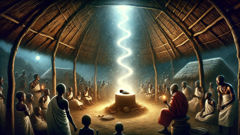
The people believed this was an omen. Stories spread quickly, carried from market to market, riverbank to farm. It was said that the child’s first cries were not of distress but of command, echoing with a resonance that made grown men pause mid-step. As he grew, Anokye was quiet but observant, his eyes large and searching. He spent hours listening to the elders’ stories, watching the healers at work, learning the rhythms of the forest, and meditating beneath the ancient silk-cotton tree that towered above the village. It wasn’t long before strange things began to happen wherever he went. A drought that threatened the crops broke after he spent a night in prayer. A snake poised to strike a child suddenly coiled away, hissing as if repelled by some unseen force. The villagers, once wary, grew to protect him, sensing that his destiny would one day shape their own.
But the wider Akan world was turbulent. The powerful Denkyira kingdom ruled with an iron fist, extracting tributes from surrounding clans. The Ashanti, scattered and often at odds, yearned for a leader who could unite them. It was during this era of uncertainty that Anokye’s reputation grew. At every gathering, his wisdom stood out. He advocated for peace, yet possessed a spirit fierce enough to challenge injustice wherever he found it. He healed the sick with roots and words, settled disputes with fairness, and foretold events that came to pass with startling accuracy. Chiefs from distant villages journeyed to Awukugua, seeking his counsel. They left with more than advice—they left with hope.
By the time Anokye reached adulthood, his fame had traveled far beyond his home. His closest companion was a young chief named Osei Tutu, whose own destiny would soon intertwine with Anokye’s. The two forged an alliance built on mutual respect: Osei Tutu’s courage and vision, coupled with Anokye’s wisdom and supernatural gifts. They recognized that the only way to free their people from Denkyira’s yoke was through unity—something no warrior’s sword could achieve alone. With Anokye as spiritual advisor and Osei Tutu as political leader, they began the delicate work of forging alliances, persuading rival chiefs to set aside old grudges for a common cause. It was not an easy path. Mistrust ran deep, and the shadows of old betrayals loomed over every council fire. Yet, again and again, Anokye’s words turned suspicion into cooperation, his miracles softening hearts hardened by years of conflict.
The stage was set for something momentous—a sign that would bind the Ashanti together, not merely by treaty or force, but by sacred purpose. Anokye knew that people needed more than promises; they needed a symbol, something to gather around, something that would outlast any one chief or warrior. As whispers of rebellion spread, the Ashanti looked to Okomfo Anokye, waiting for the miracle that would shape their fate.
The Summoning of the Golden Stool
For months, Okomfo Anokye and Osei Tutu moved from village to village, their message unwavering: unity would be their salvation. The drums of war grew louder as Denkyira’s demands became ever more severe. At last, a great council was called at Kumasi—then a small settlement surrounded by thick forest but soon to become the heart of an empire. Chiefs arrived draped in colorful kente cloth, their entourages bearing gifts and weapons, their faces painted with hope and skepticism alike. In the center of the gathering stood Okomfo Anokye, serene and formidable in his white priestly robes, his staff carved from sacred wood and inlaid with gold.

The assembly lasted for days. Arguments flared, tempers threatened to boil over, but Osei Tutu’s leadership and Anokye’s calm wisdom kept the chiefs at the table. On the morning of the final day, as a hush fell over the crowd, Okomfo Anokye rose and addressed them all. “You seek unity, but you fear losing your birthright. You seek power, but forget its true source. Let the ancestors judge us now. If we are to be one people, let heaven itself grant us a sign.”
With those words, Anokye planted his staff firmly in the earth. The wind stilled. Even the birds went silent, as if the very world were holding its breath. He began to chant—softly at first, then rising in a wave that swept through the clearing. His words were not of any language the chiefs recognized, but their meaning seemed to echo in every heart: a call to unity, to destiny, to a future greater than the sum of its parts.
Suddenly, the sky darkened. Clouds gathered, swirling in patterns both beautiful and terrifying. Lightning flashed, but there was no thunder. The chiefs clutched their staffs and swords tighter, eyes wide with fear and wonder. Then, as Anokye’s voice reached its peak, a shaft of golden light burst through the clouds. From its center descended a stool—not carved by human hands, but forged from pure gold, glowing with an unearthly light. It hovered in the air before settling gently onto Anokye’s staff.
Gasps of disbelief rippled through the crowd. Some fell to their knees, others wept openly. The Golden Stool—Sika Dwa Kofi—had arrived. According to Akan belief, it was more than a symbol of kingship; it was the very soul of the Ashanti nation. To sit upon it was to hold the destiny of the people in one’s hands. No one dared approach except Osei Tutu, who knelt before it, tears streaming down his cheeks.
Anokye declared: “From this day forth, the one who sits upon this stool shall lead not by force, but by the will of the people and the blessing of the ancestors. The Ashanti are now one—bound not by blood or treaty, but by spirit.” The chiefs pledged allegiance to Osei Tutu as king, and to the Golden Stool as the living heart of their people. The air felt charged with something new: hope, unity, and a sense of destiny fulfilled.
The Trials and Triumphs of Unity
With the Golden Stool as their anchor, the Ashanti began to forge their empire. But unity, once declared, must be tested. The Denkyira did not take kindly to rebellion. Their armies swept down upon Ashanti lands with fire and fury, determined to crush the upstart nation before it could take root. Osei Tutu led the warriors into battle, but it was Okomfo Anokye’s spiritual power that became their secret weapon.
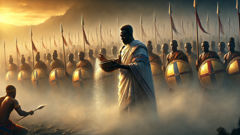
Before each campaign, Anokye performed sacred rituals—calling upon the ancestors for protection, blessing weapons with sacred water and herbs, and invoking courage in the hearts of every fighter. Stories soon spread that Anokye could make arrows turn aside, that enemy swords grew heavy as if weighed by invisible hands, that Ashanti warriors fought as if possessed by ancient spirits. Whether these were miracles or the power of belief hardly mattered; their enemies were shaken, and their own people emboldened.
Yet Anokye’s wisdom extended beyond the battlefield. He insisted that justice be fair and swift. He urged chiefs to share resources and to consult one another before making decisions that would affect the whole. He mediated disputes not only with words but with symbolic acts—sometimes planting sacred trees where blood had been shed, turning former battlefields into places of healing and remembrance. His voice carried special weight in matters of law, tradition, and faith. Under his guidance, the Ashanti developed an elaborate system of governance, rituals to honor both ancestors and gods, and a code of conduct that prized honesty, courage, and compassion.
But peace was always fragile. Some chiefs still nursed old grudges; some warriors grew restless in times of quiet. Famine threatened when rains failed. Disease swept through villages. Each time, Okomfo Anokye was at the center—praying, healing, advising, and reminding all that their strength came from their unity. When a chief defied Osei Tutu’s rule and threatened to break away, it was Anokye who visited him alone, speaking for hours beneath a moonlit sky until the chief emerged changed, pledging loyalty anew.
The greatest trial came when Denkyira’s king unleashed his most powerful sorcerers and threatened to capture the Golden Stool itself. Osei Tutu prepared for war, but Anokye counseled caution. “The soul of our people cannot be seized by force,” he warned. In a dramatic confrontation on the battlefield, as Denkyira’s army advanced, Anokye strode alone between the two forces. He planted his staff in the ground and called out in a voice that seemed to shake the earth: “Let those who would steal our soul be turned away!” The ground trembled; a great chasm opened before the enemy, halting their advance. The Denkyira fled in terror. The Ashanti had not only survived—they had become legendary.
Conclusion
As the years passed, the Ashanti Empire flourished. Kumasi grew from a forest clearing into a bustling city filled with markets, temples, and the sound of drums celebrating every harvest and victory. Okomfo Anokye remained a pillar—his wisdom guiding laws and traditions, his presence reminding all that the Golden Stool’s magic was less in its gold than in what it represented: unity, dignity, and the unbroken chain from ancestors to descendants. When Anokye finally departed this world—some say vanishing into thin air at the foot of a sacred tree—the people mourned, but not with despair. For his teachings lived on, woven into every ritual, every story shared by firelight, every oath sworn before the Golden Stool. The Ashanti would face new challenges and changing times, but they would never forget that their greatest strength was not their armies or their riches, but their unity—first imagined by a boy who listened to the wind and fulfilled by a priest who called down destiny from the sky. Okomfo Anokye’s legend endures, echoing in the hearts of all who seek wisdom, courage, and a sense of belonging in a world forever in search of meaning.

